A storied ranch—Colonizing Baja—Failed colonies and family fortunes—Revolution!—Bertie and Salve—Uncommon hosts, then and now—Profile of a collector—Uncommon coleoptera—Up the Arroyo with Lamb and Borell—Yerba Santa—A magic harvest—Lepidopterans—My interview with the bull—James’s haul of herps—Snapping into it—An ornithologist’s paradise—Making a habitat—The Meling Ranch and conservation—Summoning owls
2 June, 6am, Meling Ranch
Up early perusing the book Christian gave us, Where the Old West Never Died, a history of the Meling Ranch. It purports to be an oral history, related through interviews with Meling family matriarch Alberta (‘Bertie’) Meling (1886-1979), along with members of the Ailes family, one of the original families that made up the Colnett Colony where the Melings first got their start in Baja in 1886. It was published in 2006, but it’s a reprint of a 1968 work–a date not included in this edition: I had to reconstruct it based on the age of Bertie, 81, at the time of the interview according to the preface, and a quick confirmation on eBay, where a first edition is up for auction.

The absence of an original publication date gives the book a timeless quality, the selfsame quality the book aims to promote about the ranch, like a story out of time about a place out of time. The book weaves a romantic tale of the Ranch’s colonial beginnings in nineteenth-century Mexican land grants, to its rising fortunes as a mining colony, to its decimation during the Mexican revolution of 1910-11, and finally to its resurrection as a tourist ranch and sometime waystation for scientists (Lamb made many stops here and in fact it was an important field site in itself; in 1925 he returned with Grinnell—the only trip they made together).
It falls into the category of much Baja popular historiography, whose titles (like Baja Legends, Baja Land of Missions, Baja Dreaming: Stories from Another Time, etc.) reveal their investment in the idea of Baja as “old west” artifact, as land of story and adventure and escape to simpler times. Like those, Sanford’s is told unapologetically from a colonial perspective, celebrating the enterprising, industrious, white adventurers, pioneers, and colonists who helped found the Meling legacy, on a landscape where Mexicans play the parts of corrupt officials, marauding banditos, and false-revolutionaries, while Indians serve minor roles either as savage antagonists to westward pioneer emigration, or as a source of childlike, silent, uncomplaining labor.
The Melings acquired the Ranch in 1910, but the story begins twenty-five years earlier with the the creation of the Colnett Colony, the colonial venture of an international landholding conglomerate called, rather unspecifically and suspiciously, the International Company of Mexico. In 1886 Mexican “President Porfiro Diaz of Mexico granted more than a million acres of land south of Ensenada” (Sanford 4) to this company. As in the U.S., large corporations operating under land grants from the government had been in operation for some time. These corporations were usually American companies, sometimes English, with holdings often of “enormous size” (Nelson 9). The grants themselves operated much as they did in the north: By giving away land essentially for free, the government encouraged private development in order to reveal new natural resources and increase taxable revenue.
The International Company had its own agenda. It sold large plots of its land under the grant to norteamericanos—a catchall term for “Yankees,” Germans, Swedes, and English–in a kind of colonial conspiracy to start a colony large enough “to vote Baja California out of Mexico and into the more progressive Alta California of the north” (29).
Colnett Colony lured enterprising immigrants with promises of resources, abundant range- and farmland, and weather. One of these was Harry Johnson, father of Bertie Meling, a Danish immigrant (born Jenssen) who emigrated to Boston in 1863, and from there to Mendocino (via Panama–the quickest route available at the time–aboard a cholera-stricken steamer) where he learned placer- and hard-rock mining. He moved on to Texas eventually, where he met and married Ella Prather, Bertie’s grandmother.
By 1888, Johnson yearned to get back to California, “the source of gold,” only to find that by this time, most of the range land had gone to large companies, the ultimate beneficiaries of U.S. land-grant programs like the Homestead Act of 1862. Stymied in the U.S., Johnson set his sights on opportunities farther south, after hearing of cheap land opportunities in Lower California, near the Colnett Colony at Ensenada. Harry went first to buy up 2,000 acres along the coast. Ella came after, in a harrowing trip that lasted 5 months, during which she and her party were harassed by Apaches, nearly starved in New Mexico, and ran out of water near the Salton Sink (at the time still an “alkali marsh,” the remnants of an ancient sea floor, prior to the accidental diversion of the Colorado River that resurrected the Salton Sea in 1905).
Ella arrived in San Diego in 1889, ready to homestead, with sixty of her best cows and her cheese-making outfit. From there she headed south to San Antonio del Mar, the name of their new ranch near Colnett. Sanford’s history celebrates Ella as just one of many resourceful, self-reliant American women who helped establish the Meling legacy in Baja. She’s a mythological figure drawn straight from the epic of Manifest Destiny. The daughter of a family of “self-sufficient English and Pennsylvania Dutch people,” Ella was “as independent as any of them.” A devout Christian, she inherited the family penchant for “clean morals” and “hard work.” (Ella’s own mother had tended U.S. soldiers at the Alamo.)
Colonists like the Johnsons and those at Colnett arrived during a particularly wet period in between the region’s droughts. Capitalizing on the abundant water, they farmed grain and hay, which they sold across the border. They ate quail and deer and rabbits and made salads of wild lilac and sage flowers (6). They mined onyx from the western slopes of the Sierra, which they sold up north, to banks, and to Hollywood stars for bathtubs. “Baja California was like a paradise,” “a land of perpetual spring and summer” (7)
But the colonists’ arcadian existence was interrupted by politics and drought. The Johnsons arrived just as relations between the International Company and the Mexican government were deteriorating. The government, provoked perhaps by the Company’s agenda to help the U.S. annex Lower California, revoked the grant and gave it over to an English syndicate, prompting a trade war between the U.S. and Mexico. The colonists, whose beef and grain market had been subsidized by a free-trade agreement between the U.S. and Mexican governments, suddenly found themselves facing high tariffs imposed by the U.S. and unlawful taxes imposed by the Mexican government. Unable to recuperate the costs of their holdings, or to protect their assets from Federalistas (government agents) and cattle rustlers, many colonists left with little more than they could put in row boats, which they rowed out to steamers waiting to take them back north.
Most of the remaining colonists were finished off by a drought in 1890, when crops failed and “all hope” of colonial aspirations withered. The failure of the Company–and the Syndicate that replaced it–was typical: As Edward Nelson noted in 1905, almost all attempts made “to colonize various parts of the peninsula, mainly from the United States [were] complete failures” (9).
Of the few colonists that remained were the Johnsons, Harry and Ella. At Antonio del Mar, they had farmed and ranched happily, evidently unaffected by the political instabilities that plagued their neighbors at Colnett. But the drought of 1890 threatened their livestock: they needed to find higher-elevation pastures to graze their cattle in the hot summer months. Vaqueros (Mexican cowboys) would lead them up into Vallecitos, La Grulla, and La Encantada, the mountain meadows where water persisted year round and where ranchers had been grazing cattle since the first Dominican priests arrived in the eighteenth century (Minnich 647). And since farming was subject to the limitations of water, Harry Johnson also began putting his mining skills to use, taking advantage of a minor gold rush in Baja around this time to start a placer mining operation at Arroyo Socorro, just a few miles east of what is now Meling Ranch.
It was the mine that saved the Johnsons from the usual fate of norteamericanos in Baja. As the history of failed colonies and companies attests, the Johnsons’ success is anomalous. The Socorro Mine was among the few extractive ventures to succeed in the Sierra, securing the Johnson family fortunes and allowing them to weather tough droughts that had chased off most other economic interests in the region.
In the Johnsons’ time, Meling Ranch was called San Jose because it sits in San Jose Valley. It would have been a true oasis to travelers through the dry and often inhospitable region. The Ranch had been a regular way station for the Johnsons, between their coastal holdings at San Antonio del Mar and their mining and grazing operations farther up slope at Socorro and the meadows. Thus it made sense to bring San Jose into the family as part of their Sierra ventures. The Johnsons’ daughter Josie and her husband Liss Waldripp purchased the Ranch title in 1910 from Carmen Mandriguez, a descendant of the first grantees to the land from the Mexican government.
The Johnsons worked the ranch and the mine until 1911, when insurrectionists fighting under the banner of the Mexican Revolution began stealing cattle and burning ranches of norteamericanos in the region. The Johnsons stuck by San Jose to protect their property, but eventually fled to Ensenada after Harry died of pneumonia: he’d been caught in a heavy downpour while packing out mining equipment to San Diego. When Ella and her children returned to San Jose, they found the ranch looted and burned it to its adobe walls. They rebuilt in 1913 with the help of Salve Meling, a Norwegian who’d arrived in 1908 and whom Bertie married. Meling ran the ranch when Lamb and Grinnell stayed here: he was a “very experienced and reliable cattleman,” according to Grinnell (9/28/1925 FN 2552-53).
By this time, the Socorro mine had been abandoned and the Melings’ fortunes were tied to cattle ranching and dairy. Between 1924 and 1949, the Ranch prospered, but a prolonged and severe drought between 1949 and 1963 reduced their cattle holdings from a few thousand to just a hundred and fifty or so. Between 1963 and 1979, Bertie saved the ranch by transforming it into a guest ranch for explorers, mountaineers, hunters, and tourists, thus beginning its final phase as part of the Sierra recreation industry.
After Bertie died in 1979, her daughter Aida (1915-1998) took over the Ranch. Aida, who’d collected lizards for Grinnell in 1925, ran the Ranch for 40 years. Aida’s daughter Duane Barre took over in 2000, and Christian, our current host, purchased the Ranch in 2007 or so and has operated it since.
Where the Old West Never Died’s colorful, romantic history appeals to Christian’s European and norteamericano clientele in search of some vestige of the experience of the west that can’t be found in Alta California. It creates the ranch as an artifact taken out of historical circulation on a landscape that functions like a museum. But this function obscures what the book might have been intended to be: a political argument for–if not outright annexation–then the roots of Baja in American colonial perseverance, moral steadfastness, ingenuity, and self-reliance.
This story, which greets us on our first full day (literally handed to us upon our arrival), probably allows Christian to charge U.S. prices in a Mexican market and is likely material to the Rancho’s continued prosperity. But the story also offers to claim our experience of this landscape. Christian’s gift of the book arrives like an event, a device to move along the plot in the story of a landscape, and it couldn’t have been written better. That it came like a preface to our expedition, apparently freely and unbidden and demanding our humility (“what, you don’t accept gifts?”), makes it all the more literary.
There will be other histories, as we’ll discover, that compete for interpretation of the Sierra; and this journal is of course one of them.
2 June, 7am, Breakfast, Meling Ranch
Christian carries on the family tradition of hospitality. He dines and breakfasts with us and obliges all our questions. At breakfast with Christian, John, and James, I learn a little more about James. James grew up in Rochester, New York, where he learned to hunt and fish with his father. He moved to Alaska for college where he actively pursued bird hunting, and which led to a job collecting and preparing birds for the University of Alaska Museum of the North. Before John lured James to Los Angeles to take up a post as Collections Manager of the Moore Lab, James lived in Wyoming, working as a collections manager for another museum there, and where he hunted grouse and jackrabbits. Christian expresses some surprise that a bird scientist would be into hunting, but John explains that museums tend to sit at the intersection of hunting and collecting and tend to attract a certain sort of scientist, the hunting type. James exemplifies this type precisely.
We converse briefly with Rolando, our guide for tomorrow’s trip to La Grulla. Spanish only. He’s a large, thick-set old vaquero, in his sixties, with tree-limb-like arms tattooed by years of sun exposure, an impressive gray mustache, and small, friendly, beaming eyes. We arrange to meet up with him at Vallecitos, the trailhead to La Grulla, where he’ll pack up our kit and guide us to the meadow.
2 June, 9am, Rancho Meling
After breakfast, we start our “naturalizing” for the day—that is, snapping photos of anything that crosses our paths. Around the main lodge, near a huge pecan tree full of nesting Kingbirds, James spots a large, seed-like insect, the Ten-lined June Beetle, which gives out a gassy hiss when I try to nudge it a little to make its portrait. A little farther out, to the south in the sage scrub, I spot a pair of Black Jackrabbits—skittish animals with long ears that glow pink in the morning sun.


We set off in different directions and see quickly why the place has been so often visited. It sits at 500m in a wide, fertile valley dotted with granite hills and, farther out, ringed by juniper forests. It’s high enough sometimes to get snow in winter and exhibits a variety of habitats, including sage scrub, hills of buckwheat and cactus, and a wet, willow-lined arroyo—El Rio San Telmo—east of the ranch running north-south. The northerly section of this arroyo used to be an orchard, but has reverted to a low-lying sandy floodplain forest filled with willows, alders, sycamore, and large stands of yerba santa. To the south, the creek pools into a small marsh pond dense with vegetation. Beyond the arroyo to the east lies the grazing pasture, interrupted by a granite hills covered in buckwheat and a variety of cactus. Beyond the pasture, an air strip.
I choose the north section of the Arroyo for my walk. Lamb and Borell trapped and shot along this arroyo: we’re literally walking in their footsteps and have their hand-drawn maps to prove it. I probably cross Borell’s mammal trap line a dozen times.

I first ascend one of the low hills to get a glimpse of the cactus: mostly diamond cholla and a species of caespitose (clustered) cactus, hedgehog or cochemia, that bear yellow flowers and host a species of small bee that busily works the anthers. On my way down I observe another distinctive species of “Blue” butterfly, the Sylvan Hairstreak. This species of Blue looks unremarkable, with just a few black spots in a line on fore and hindwings, except for a single orange spot on its hindwing and a “tail”, both easily missed. This species is common in California, but this observation turns out to be the first on iNaturalist in Mexico. Likewise for the Bernardino Blue (Euphilotes bernardino), a much more striking member of the Blue family with five distinct orange squarish dots on the underwing. Like many Blues, these species host on willow and feed on the nearby perpetually blooming buckwheat.


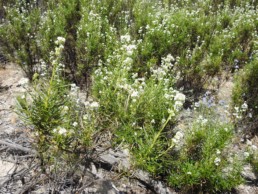
At the bottom, I find myself back in the riparian forest of willow and fragrant Narrow-Leaved Yerba Santa. Yerba Santa is common above 2000 feet in southern California and Arizona, the nearest equivalents of northern Baja, but I’ve never seen this species in California before. The leaves are narrow and glossy, but still characteristically sticky and aromatic like the thick- and hairy-leaved varieties I’m more familiar with. Perhaps the narrow leaf is a further climatic adaptation for a plant that is already dry-adapted? Its leaves are single-veined and lanceolate and the flowers are small, star-shaped, and white. You can chew the leaves: they’re reminiscent of peppermint gum and they’re said to stave off thirst, which seems useful here.
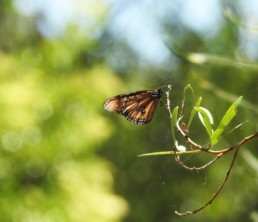
Farther into the forest, under the tree canopy, I startle a host of 6 or 7 Striated Queen butterflies gathered at ground level on Alkali Heliotrope: a plant with thick, soft green ovate leaves with three scorpiate, unfurling inflorescences of a white-purple star-like flower. Like another species of Danaus, the Monarchs, these Striated Queens host on milkweed, and are found in a variety of habitats in the southern United States, so perhaps these are males feeding on the heliotrope. This creature seems diaphanous in the air, like floating crepe paper lit up by the sun. Its upper wings are orange-brown with black margins and white spots on both fore and hindwing, as well as all over the insect’s body—giving the impression of a polka-dotted costume. The underwings are “striated” (lined) with black veins.
In the wash, too, are dense fields of Yerba Mansa—a lettuce-like plant in the “lizard tail” family, composed of many triangular, softly serrated leaves, with white 4 or 5 petal “flowers” (bracts) that display a single conical “spike” or cone of many small dense flowers. This plant has many medicinal uses, and its leaves can be chewed. It is indicative of alkali (salty) soil, and grows only in the wettest parts of an arroyo. Its distribution is concentrated in the southwest, California, Arizona, New Mexico, and Texas, where it has been harvested by curanderos and curanderas who refer to it as yerba del manso. Seeing this plant I can’t help but recall the young Antonio, in Rudolfo Anaya’s Bless Me, Ultima, who walks with the curandera Ultima to gather this “magic harvest.”
At the lowest and wettest point of the arroyo there is a wide sandy arenal filled with Blues and Buckeyes. I spy a few other curious creatures here, including dragonflies like the familiar Flame Skimmers, the smaller but still vibrant red Cardinal Meadowhawk, and the blue California Dancer, as well as a species of metallic wood-boring beetle, elegantly inlaid with a gold filament.
I’m recalled to the ranch by the lunch bell (bells for meals are a charming convention on the ranch), but not before an uncomfortable encounter with one of Christian’s large white bulls, who watches me warily and makes some startling noises—whether in fear or aggression I don’t know and don’t care to test. Having no reliable place to climb or hide, I give the creature a wide berth and retreat into some willows for a minute or two. When I venture out again, he’s gone, my interview with the bull thankfully concluded.
2 June, 1pm, Ranch Meling main lodge
At lunch, everyone is excited to share their observations. James has the most exotic tales to tell, having spotted a host of endemic lizards: the Granite Spiny Lizard, the Orange-throated Whiptail, Cope’s Leopard Lizard, Baja Spiny Lizard, and—the winning observation of the morning–the Baja Brush Lizard.
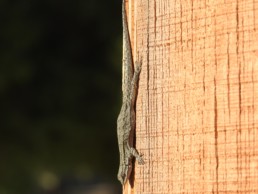

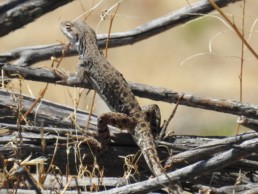

James is truly an expert naturalist, and an inspiration. He’s constantly researching, reading and rereading the old notes, and always seems uncannily aware of what we should be looking for in any location—having prepped and memorized in advance of the trip. John knows his team’s value and behaves accordingly: this morning he and Whitney volunteered for the tedious job of packing up food for La Grulla simply to give James a chance to explore the ranch and do what he does best.
I’m starting to learn the team’s lingo: “snap into it!” means snap a photo—a sort of Cockney slang derived from “Snap into a Slim Jim!” This is shouted with some excitement in the field when an opportunity presents itself. Sometimes, it is shortened simply to “snap it!” and often made interrogative: “did you get any good snaps?” “Teaming” is a gerund of the verb “to team”, as in, “we’re teaming” when collaborating in the field to get some good snaps. The argot is fun, but it also reveals an important division of labor on this expedition. For example, Devon doesn’t snap: he uses “bins” (binoculars) to spot a bird, then we all team to snap into it.
The practice of sharing observations becomes a ritual on the expedition and eventually I learn to love it. But early on I feel pretty inexpert and not entirely sure what I should be doing. There are no further re-photos to find and shoot here, and hanging around the ranch reading seems silly when there’s so much diversity to experience. So I take my cues from the crew and do my best naturalist impression: exploring, recording, processing, and sharing.
2 June, 4pm, Rancho Meling
It’s hot after lunch, in the 90s and under unrelenting sun, so we hang around the ranch until 4, when we set out again to explore the arroyo, this time to the south looking for a few of the birds yet to be observed from Lamb’s list. This is an amazing naturalist’s walk along Lamb and Borell’s arroyo “cut”: a willow-choked stream captured by a 15’ escarpment to the east, which eventually gives way to a sandy reservoir filled with reeds and even marsh birds like Killdeer, not seen here in Lamb’s time.
San Jose has been an ornithologist’s paradise. Lamb’s list of birds observed was long. In 1925, between the two of them, Lamb and Grinnell noted 45 different species. Now the most common birds in the arroyo are Lesser Goldfinch, Phainopepla, Bell’s Vireo, House Finch, and Blue-gray Gnatcatcher. Nearer the ranch there are House Sparrows, Brewer’s Blackbirds, Eurasian Collared Doves. There’s a family of Kingbirds–a smallish (6”) birds with a yellow-green belly—in the pecan tree in the middle of the ranch. (There’s some contention between James and Devon over whether these are Cassin’s or Western Kingbirds. James suspects they’re a hybrid, which means I have no chance of getting them right.) The woodpeckers here, notes John, are the real situation, both Nuttall’s and Ladder-backed. We even observed some agonistic interaction between males of the two types.
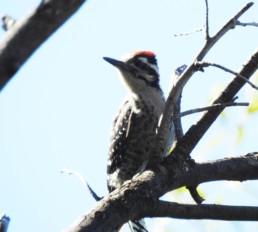
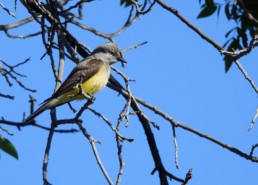
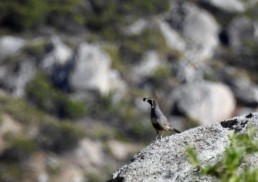
Farther to the south on our walk, we head up toward the buckwheat and cactus hills, their boulders hiding lizards and California Quail in huge abundance. They seem to act very much like small colonial mammals, like ground squirrels, with sentinels on rocky outposts. We spook whole families of them. (Lamb estimated he’d scared up about 400 hundred of them in a single event on one of his outings.) These birds announce their retreat in a thunderous booming, designed perhaps to startle and confuse the predator or the naturalist.
We also spy a pair of California Thrashers, some Red-wing Blackbirds, and a Kestrel. The only species of Lamb’s we have not recorded are the House Wren and Western Screech-Owl but with the marsh-bird species we’ve now recorded more diversity than they did.
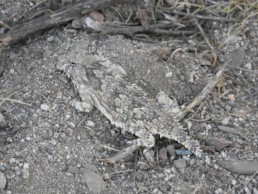
James spots a rare, Baja endemic Cedros Island Horned Lizard and scoops it up with his hands—a nearly flat animal and almost invisible in the sand, except that its scurrying gave it away. It looks transported from some miniature world of fantasy dragons: delicately serrated scales and a spiny-helmeted head glint like metal in the late-afternoon sun. Its armored appearance belies a gentle disposition: the animal sits patiently (or maybe in quiet terror) while we pass it around and marvel before releasing it back into its sandy retreat.
2 June, 6pm, Rancho Meling, main lodge
At dinner, Christian tells us more about the pond we saw, evidence of his trout-stream aspirations. He began the project two years ago, with the intent to stock it with the Rainbow Trout that is endemic to the Rio Santo Domingo that we intend to visit later in the trip, and which has been used to populate other mountain rivers and streams as well. The marsh is quite large, produced by capturing water between massive earthen berms. Christian is taking the project slow. In the meantime, frogs have colonized. The scientists that come to study them have tried to convince him not to bring in trout, which will eat frogs’ eggs and tadpoles. Despite that the frogs don’t bring the guests—except maybe a few scientists—he seems to have conceded in some regard, and claims he may make a frog pond in addition to a trout stream.
It’s quite remarkable that creating habitat like this will attract animals to an otherwise very arid region. This pond is the source of the Red-winged Blackbirds we’ve been seeing. Also Yellowthroat and Killdeer. But where are these birds coming from? And the frogs?
The presence of these animals at the Ranch may demonstrate the importance of private ranchos in conservation and land management. The land is largely intact, continuously operated and owned by a family, and little changed since 1910. It has preserved habitats and species under its umbrella, a testament to the Meling family’s stewardship dating from Bertie’s time. In the 1960s, the Melings promoted responsible hunting of quail, rabbit, and deer on their property, setting limits and insuring “illegal and irresponsible slaughter” (99) was kept to a minimum. Outside the Ranch, as near as the Socorro mine just three miles east, Borell noted few hunting protections: “everyone kills all he wants at any time of the year” (5.8.1925, 285). The Ranch, by contrast, promoted intelligent, sustainable land and game management outside either of the two dominant land-management systems in the region, the ejido and the National Park systems. If Christian is ever able to develop his trout stream, he’ll also have contributed to the long-term viability of a rare endemic fish.
After dark, Devon and James hunt for owls, which they summon using an iPhone app of bird calls. They spot two small screech owls in the pecan tree at the ranch, smallish birds whose hoots begin slowly and become increasingly rapid and high pitched: “woo….woo…woo..woo.woo.woowooWOOWOO!” until the syllables follow on one another nearly without break. We also see and hear bats on the wing, swooping and hunting for nighttime insects. We enjoy a beer and a chat before retiring to bed for reading and writing. This is done by headlamp and oil lamp: the generator at Rancho Meling cuts out at 9pm and doesn’t turn on again until 7am.



